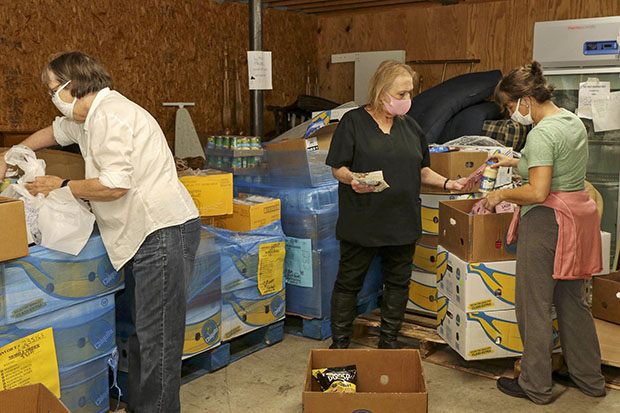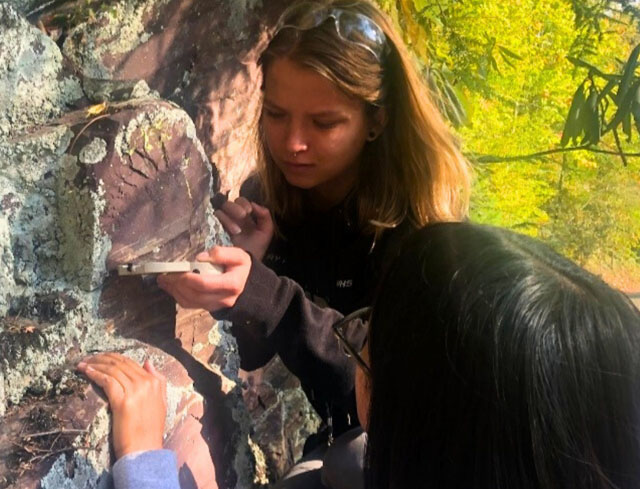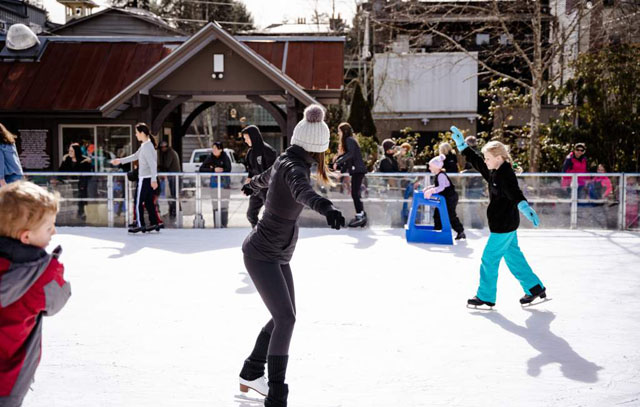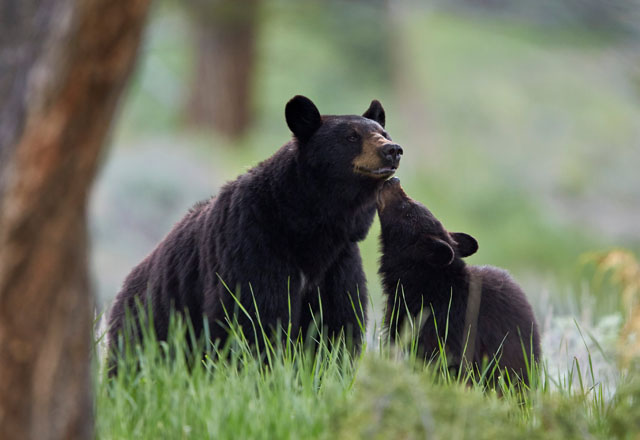On the Edge of Wilderness
03 Feb 2021
Honoring history and protecting the future through conservation
By: Brittany Conley
Photos by Trout Unlimited, Mainspring Conservation Trust, Headwaters Outfitters
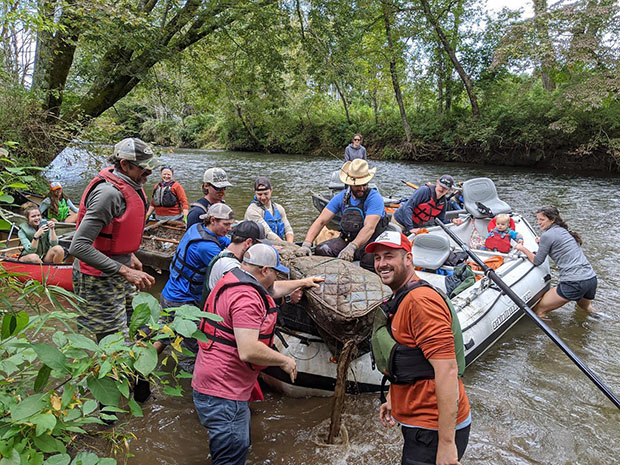
What do you love most about the Highlands-Cashiers Plateau? Perhaps it’s the smorgasbord of fine dining restaurants and boutique shopping, or maybe it’s the scenery and endless opportunities for outdoor recreation. For me, it’s both. It is the sensation of having one foot in the forest and the other in the village—a beautiful, gentle dichotomy other places haven’t achieved in quite the same way. It’s a feat over 100 years in the making and yet a work in progress. For the groups tirelessly striving to keep this area in a harmonic balance of commerce and countryside, it is a labor of love. Love for the land, the wildlife and the people.
History of Preserving the Plateau
In 1883, a relatively small group came together to form the Highlands Improvement Association, the precursor to today’s Highlands-Cashiers Land Trust. This initial group’s primary goal was to protect the beautiful land while sharing it with the people. They accomplished this by building trails and planting trees to combat deforestation until their ambitious plans grew. In 1909, the HIA raised $500 to purchase 56 acres on Satulah Mountain, thus becoming the first land trust in North Carolina and among the first 20 in the United States.
Today, the tract of land on Satulah Mountain managed by the HCLT has doubled in size and Satulah remains largely unperturbed by development and every bit as cherished as those forward-thinking conservationists knew it would be. It, and other conserved areas, are often listed first among the reasons newcomers are attracted to this area.
Another well-known conserved property is Ravenel Park, donated to the HCLT in 1914 by the children of one of the first families to settle in Highlands when the town was newly established. The Ravenel children wanted to honor their family’s heritage and contributions to the plateau while protecting the very land where they grew up. Now protected and maintained by the HCLT in perpetuity, the park is home to the famed Sunset and Sunrise Rock trails and is perhaps the most visited place in Highlands, estimated to host 20,000 visitors yearly.
While we enjoy places like Ravenel Park and Satulah Mountain, among others, quite a bit of conserved land goes mostly unnoticed by the general public. The HCLT now protects over 3,000 acres in the plateau area, and Franklin, NC based Mainsprings Conservation Trust has conserved over 28,000 acres in the region, with many notable projects of their own such as the massive Needmore Game Lands and Pinnacle Park. These lands are safeguarded for countless reasons, ranging from historical significance to conserving agricultural lands and maintaining habitats for numerous species of plants and animals. “The first thing we assess is the conservation value,” says Kyle Pursel, stewardship coordinator for Highlands-Cashiers Land Trust. “Is there historical significance? Does the property have the potential to impact water quality?” Pursel explained the brainstorming that goes on when considering projects. There is a lot of criteria to meet and hurdles to overcome.
Often, these conservation groups partner up to get the job done, not only with each other, but with entities like Friends of Panthertown, the U.S. Forest Service and other nonprofits such as Trout Unlimited. “We all have a common goal in that we want to conserve the land,” says Jordan Smith, executive director for Mainspring Conservation Trust, emphasizing that it isn’t ego or competition that drives them, which makes it natural for these groups to come together, often pooling their resources to preserve our resources.
The Land Conservation Domino Effect
Aside from public parks and accessible hunting lands, what benefits are there from these preserved properties? Our slice of Appalachia is one of the most biodiverse places in the country, and there are many species—both animal and plant—that thrive because of the expert management from our local land trusts and other nonprofits. They care for the land with a deep understanding of its delicate interconnectedness, which helps maintain that biodiversity. Our cliff-dwelling peregrine falcons, for example, benefit greatly from improved soil conditions because it provides healthy food sources for the peregrine’s greatest food source, songbirds. We enjoy living, working and playing on the edge of wilderness, which comes with the responsibility of caring for the precious ecosystems among which we live.
High up in our hills, we are blessed with gorgeous, old-growth forests that are home to some ancient, towering eastern hemlocks—reaching upwards of 160 feet high and estimated to be approaching 500 years old, according to Dr. Gary Wein, executive director of the Highlands-Cashiers Land Trust. These stunning trees have been under attack by the hemlock woolly adelgid, an invasive, near-microscopic insect compared to the colossal trees they’re wiping out. Thanks to vigilant monitoring by several local groups, including the HCLT, and the release of beneficial insects that are natural predators of the adelgid, several area hemlocks have so far been spared devastation.
Invasive, nonnative plants also pose a threat. Kudzu, a plant we are all familiar with, grows quickly and can cause a fair amount of destruction. “[Kudzu] ... prevents oaks from producing acorns. A hillside overtaken with kudzu basically eliminates the habitat for species in the area,” says Paige Engelbrektsson, the nature center education specialist for the Highlands Biological Station. Engelbrektsson urges homeowners to commit to only using native plants in their landscapes, and if a manageable invasive species such as English ivy is present, to work towards eliminating it as best they can. Kudzu, however, is far too prolific to battle alone, and that is where an organization such as the Coalition for Nonnative Invasive Plant Management proves highly beneficial to the community.
Using native plants not only helps combat issues from their nonnative counterparts, but it creates a healthier, thriving population of pollinator insects. “The thing about nonnative plants,” says Kyle Pursel, “is it’s kind of like junk food...some have no nutrients at all.” Caring for the land and protecting species such as our giant eastern hemlocks to the smallest wildflowers that feed our butterflies and honeybees impacts all other types of wildlife in our area.
Caring for Our Waterways
Our picturesque lakes, rivers, streams and waterfalls attract all kinds of people, from hikers and photographers to avid anglers—and keeping those waterways clean is a never-ending task for many groups and organizations. Two local retailers, Headwaters Outfitters and Brookings Anglers, take the health and vitality of the plateau’s waterways very seriously. “One of our biggest concerns is roadside trash,” says Jessica Whitmire, operations and marketing manager for Headwaters Outfitters.
Teaming with other local businesses, Headwaters Outfitters has sponsored a major clean-up project on the upper French Broad River annually for over 30 years and have since removed over 15 tons of trash, including hundreds of old tires and even the occasional mattress and box springs. “We are thankfully seeing less historical trash,” Whitmire says. “It is getting better, but there is always room for improvement. We can all step it up a little more.” Whitmire does not believe most people litter on purpose. Instead, the bulk of what is seen now comes from improperly secured garbage or has escaped vehicles when doors are opened—accidental culprits from well-intentioned people. Unfortunately, there are still some who do not utilize garbage cans when visiting our parks and scenic spots, which adds additional work for staff and volunteer groups—and much of it ends up in our waterways.
Matt Canter, owner of Brookings Anglers, agrees, although it isn’t only garbage he wants people to consider. Beneath the surface of the water is a complicated and fragile ecosystem that not only benefits tremendously from getting rid of the obvious pollution, but needs special consideration during property development, and it starts with healthy insect populations. Stoneflies, for example, spend 99% of their life cycle underwater, and they need the rocky river bottom to survive. Silt runoff from development sites can travel for miles downstream before it settles over these rocks, potentially disrupting the stonefly, a major food source for our beloved trout.
“And the trout need the rocks to lay eggs, as well,” says Canter, making the degradation of rocky river bottoms doubly troublesome for one of the area’s most iconic and popular fish: the brook trout. To further complicate matters, along some of our riverbanks we’re inadvertently raising the temperature of the water as well. “[Trout] need cool water,” Canter says, specifying 70-degrees or below. “When we remove canopy cover over the rivers, they get more sunlight and start to warm up, and during the summer months we’re already warm enough,” he says, underscoring the benefit of leaving riversides intact whenever possible.
In order to find solutions for this broad issue, Canter has partnered with Trout Unlimited, a nonprofit organization dedicated to improving and conserving trout habitats all across America. A huge operation to revitalize some key watersheds is already underway. The Sky Island Project, spearheaded by Trout Unlimited, will reconnect tributaries along the Davidson River to create habitats more conducive to spawning and also aims to create a path to cooler waters along the Tuckasegee River, just to cite two of the project’s ambitions. Jeff Wright, the Southeast coordinator for TU, says the area is the perfect place for such a project with “the elevation needed, water cold enough for trout, intact forests and a good amount of public ownership and protected lands.”
Keith Curley, TU’s vice president for Eastern conservation, says the Sky Island Project will work on everything, “from sources of pollution, to barriers that prevent movement, to making sure there is shade along the banks,” adding that while trout may be the primary focus, many other animals benefit from these efforts as well, such as the hellbender salamander.
There is a significant benefit to local businesses by doing all of this outstanding work, as well. “Clean water attracts more people, and they tend to stay longer, which is good for all of us,” Jessica Whitmire points out. There is plenty of evidence to support the theory, with nothing more convincing than the droves of people who journey to the plateau every spring and summer for fishing, kayaking and other watersports—visitors who ultimately shop and dine locally.
Getting Involved
Aside from the importance of conservation, there was one more sentiment universally shared by each of the organizations and businesses interviewed: the people of the Highlands-Cashiers Plateau care. Kyle Pursel summed up the participants’ consensus: “The really neat thing is that the people here really get it,” he said. Historically, thousands of volunteers have shown up year after year to give back, either by rolling up their sleeves and partaking in the nitty-gritty work of trail maintenance or cleaning up rivers or by donating food and water for workers, tents for some much-needed shade or money to help offset the costs of conservation efforts. Others work with the local land trusts to see if donating land would be beneficial, while some make regular monetary contributions to the land trusts to ensure they can keep doing their good works.
While COVID-19 still complicates planning events, many of these groups offer fun, educational classes and lectures you can access online. Once circumstances permit, be on the lookout for kid-friendly courses and programs such as Mainspring Conservation Trust’s Kids In The Creek program, where kids go snorkeling to learn about river health, or Trout Unlimited’s program, Trout In The Classroom, where students actually get to raise trout from eggs to fingerlings.
There are a plethora of ways you can make a difference. If you’re interested in learning more about getting involved as a volunteer or otherwise how to contribute to these great causes and projects, reach out to the following and be sure to join them on social media. One person can make a profound impact; it might as well be you.
Highlands-Cashiers Land Trust
www.HiCashLT.org
Mainspring Conservation Trust
www.MainspringConserves.org
Headwaters Outfitters
www.HeadwatersOutfitters.com
Brookings Anglers
www.BrookingsOnline.com
Trout Unlimited (There are several local chapters in the area)
www.TU.org
Highlands Botanical Station


